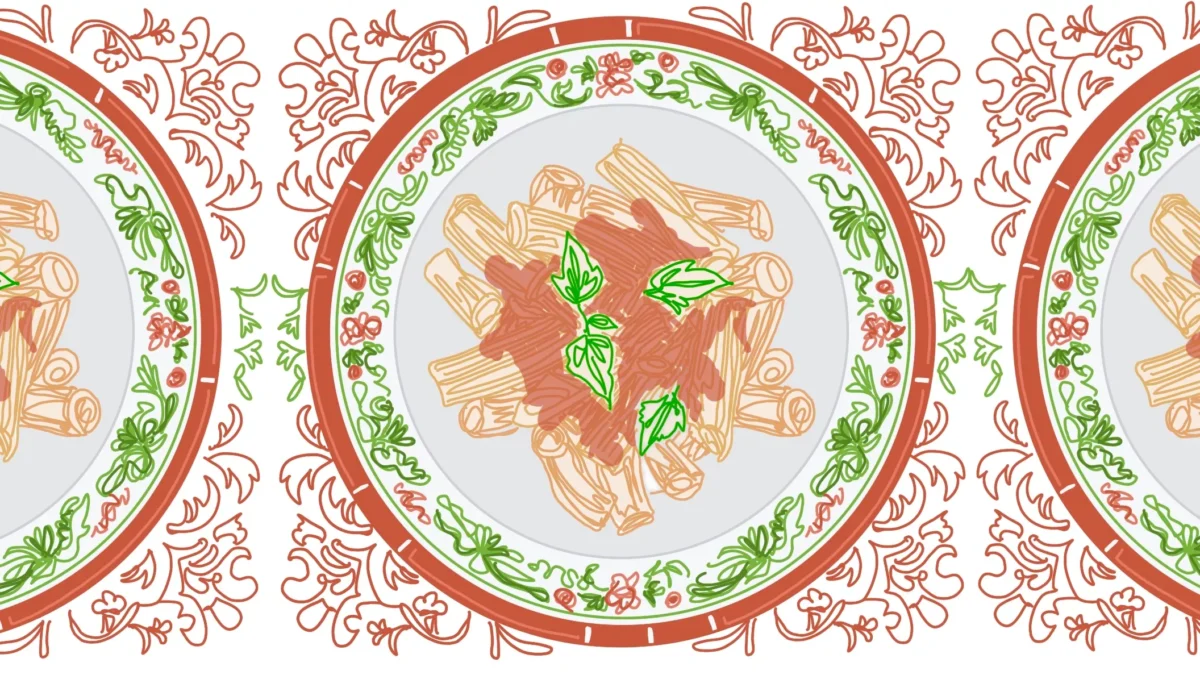Guanciale: Italiamo, High Street
Elliot Koubis writes how students can improve their pasta with guanciale from Italiamo, and gives his recipe for rigatoni all'amatriciana. Illustration by Niamh Walker.
We all make basic pasta. Empty fridge? No time? Decision fatigue? Basic pasta makes everything better.
I used to call my version of this scenario ‘kitchen-sink pasta’. I used to make vegetable-loaded pasta crammed with leftovers that satisfied my budget and my calorie intake, but rarely my tastebuds. In the process, I fell out of love with pasta and dismissed it as a functional, yet boring answer to dinner. Why couldn’t I really enjoy it?
On holiday in Rome and Bologna, I noticed why. Firstly, I was putting too many elements in. Three to five high-quality ingredients, cooked well, were all I needed.
Secondly, I discovered guanciale, or seasoned pork cheek. Crisp, yet creamy, it lends so much depth of flavour to carbonara and amatriciana. This was the ingredient I’d heard Stanley Tucci mention in his Roman episode of Searching for Italy, whose praises he’d sung with much Italian moaning.
So, how was I going to smuggle it out of the country?
Italian readers will think I’m crazy for ‘discovering’ guanciale. But in the UK, for some reason, we only know its blander, posher cousin, pancetta. Here, guanciale is rarely sold outside of Italian delis, so English-language recipes often substitute it for pancetta or bacon. Even the English-language version of the Silver Spoon, the famous compendium of Italian recipes, passes over the earthy richness of guanciale in favour of pancetta.
But you’re worth more than that.
Luckily, in Oxford, we have Italiamo, an Italian deli and sandwich shop opposite Exam Schools. For about £6 with a student discount, you can buy a packet of guanciale large enough to make four servings of pasta. They aren’t paying me for this, but if they’re interested, I’ll happily take my payment for this sponsorship in guanciale. Grazie.
Below, you’ll find my recipe for Rigatoni all ‘amatriciana, a tomato sauce souped up with guanciale. My recipe is adapted from (the amazingly-titled) pasta.com, itself an adaptation from the recipe used by Armando al Pantheon in Rome. Amatriciana forms one of the four classic Roman pastas, the others being carbonara (guanciale, eggs and pecorino), alla gricia (same, without the egg) and aglio e olio (just oil and garlic). See how many of these recipes feature guanciale? Three out of four can’t be wrong.
(If you need a veggie version, look up Gordon Ramsey’s marinara. Without meat, however, you’ll need to cook the tomatoes for an hour and a half to get a robust flavour out of them!)
***
Rigatoni all ‘amatriciana
Serves 4 (about £3.50 per serving)
Prep time: 5 mins
Cooking time: 1 hour
Ingredients:
– 250g guanciale
– 300g rigatoni, or another pasta that can take thick tomato sauce
– 1 large onion (optional)
– 2 x 400g cans of tomatoes (spend more on good quality ones if you can)
– 2 tbsp butter (salted or unsalted)
– Pecorino, 170g
– Fresh basil, to serve (optional)
– Salt and pepper, to taste
1.) Dice the guanciale. Put into a large frying pan, cold, then put on a medium heat and fry in its own fat for about 15 minutes (25 minutes if not using onions). If using onions, peel and halve one, slice thinly into strips, then fry it in the guanciale fat for a further 10 minutes until brown and crispy. Don’t skimp on the cooking time here: it’s worth slowly developing that crispy-creamy combination, otherwise the guanciale will be chewy and disappointing.
2.) Add the tomatoes. Bring to a boil, then simmer for 20 minutes.
3.) Meanwhile, boil a saucepan of very salted water (don’t skimp!) and add the rigatoni. Cook for around 7 minutes, or until al dente. Drain and save a cup of pasta water.
4.) At the end of the cooking time, add 2 tbsp butter and a good grating of pecorino, about 40g. Stir until creamy. Add some of the pasta water to taste and reduce for a few minutes. Add pepper to taste (you shouldn’t need to add any more salt).
5.) Stir the sauce through the pasta, plate up, add more pecorino to taste, and top with torn basil leaves. Serve.
Tips:
– You can brown onions further by adding salt and a pinch of sugar. Sugar can also serve as a good corrective for sub-par tinned tomatoes (as can balsamic vinegar).
– Batch-cook the sauce and refrigerate or freeze. You can then boil pasta as needed throughout the week to save time, adding pasta water, butter, and tomato purée to bulk it up.

